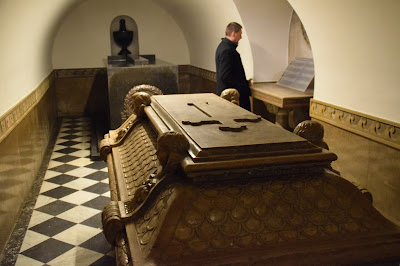The Royal Cathedral has witnessed many coronations, funerals and
burials of Poland’s monarchs and strongmen over the centuries. This is
the third church on this site, consecrated in 1364. The original was
founded in the 11th century by King Bolesław I Chrobry and replaced with
a Romanesque construction around 1140. When that burned down in 1305,
only the Crypt of St Leonard survived. Highlights include the Holy Cross
Chapel, Sigismund Chapel, Sigismund Bell, and the Crypt of St Leonard
and Royal Crypts.
The present-day cathedral is basically a Gothic
structure, but chapels in different styles were built around it later.
Before you enter, note the massive iron door and, hanging on a chain to
the left, huge prehistoric animal bones. They are believed to have
magical powers; as long as they are here, the cathedral will remain. The
bones were excavated on the grounds at the start of the 20th century.
Once
inside, you’ll get lost in a maze of sarcophagi, tombstones and
altarpieces scattered throughout the nave, chancel and ambulatory.
Among
a score of chapels, a highlight is the Holy Cross Chapel (Kaplica
Świętokrzyska) in the south-western corner (to the right as you enter).
It’s distinguished by the 15th-century Byzantine frescoes and the red
marble sarcophagus (1492) in the corner by Veit Stoss, the Nuremberg
sculptor known to Poles as Wit Stwosz.
Ascend the tower accessible
through the sacristy via 70 steps to see the Sigismund Bell (Dzwon
Zygmunta). Cast in 1520, it’s 2m high and 2.5m wide, and weighs 11
tonnes, making it the largest historic bell in Poland. Its clapper
weighs 350kg, and eight strong men are needed to ring the bell, which
happens only on the most important church holidays and for significant
state events. The views from here are worth the climb.
From the
nave, descend from the left-hand aisle to the Crypt of St Leonard , the
only remnant of the 12th-century Romanesque cathedral extant. Follow
through to get to the Royal Crypts (Groby Królewskie) where, along with
kings such as Jan III Sobieski, many national heroes and leaders,
including Tadeusz Kościuszko, Józef Piłsudski and WWII General Władysław
Sikorski, are buried.
The showpiece chapel is the Sigismund
Chapel (Kaplica Zygmuntowska) up the aisle and on the southern wall.
It’s often referred to as the most beautiful Renaissance chapel north of
the Alps and is recognisable from the outside by its gilded dome.
Diagonally
opposite the Sigismund Chapel is the Tomb of St Queen Hedwig (Sarkofag
Św Królowej Jadwigi), a much beloved and humble 14th-century monarch
whose unpretentious wooden coronation regalia is on display nearby.
In
the centre of the cathedral stands the flamboyant Baroque Shrine of St
Stanislaus (Konfesja Św Stanisława), dedicated to the bishop of Kraków,
canonised in 1253 and now the patron saint of Poland. The silver
sarcophagus, adorned with 12 relief scenes from the saint’s life, was
made in Gdańsk between 1663 and 1691; note the engravings on the inside
of the ornamented canopy erected about 40 years later.



















No comments:
Post a Comment